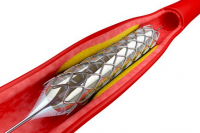








A stent is a tube or other device placed in the body to create a passage between two hollow spaces in medicine, and stenting is the placement of such a stent. There are a wide variety of stents used for different purposes, from expandable coronary, vascular and billiary stents, to simple plastic stents used to allow the flow of urine between kidney and bladder. Stent is also used as a verb to describe the placement of such a device, particularly when a disease such as atherosclerosis has pathologically narrowed a structure such as an artery.
The first use of a coronary stent is typically attributed to Jacques Puel and Ulrich Sigwart when they implanted a stent into a patient in Toulouse, France in 1986.It was used as a scaffold to prevent the vessel from closing and to avoid restenosis in coronary surgery - a condition where scar tissue grows within the stent and interferes with vascular flow. Shortly thereafter in 1987, Julio Palmaz (known for patenting a balloon-expandable stent) and Richard Schatz implanted their a similar stent into a patient in Germany. The use of these bare-metal stents helped reduce the incident of restenosis from 30-40% in coronary surgery to 20-30%.
Though many doctors have created the stent, the first FDA approved stent was invented by Gary S. Roubin.
To further reduce the incidence of restenosis, drug-eluting stents (DES) were introduced which consisted of stents coated in anti proliferative agents. Animal studies and later clinical trials showed a reduction in restenosis to approximately 5%.